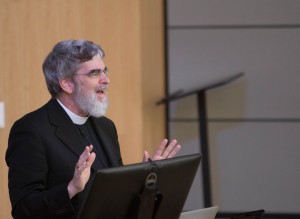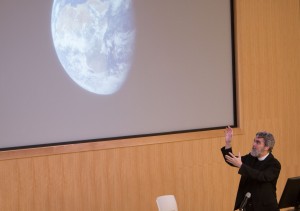Scientists, scholars and professors spoke at the Second Interpreter Science and Mormonism Symposium on the theme balancing science and religion on Saturday.

The keynote speaker from the Vatican Observatory, Brother Guy Consolmagno SJ, stressed the relationship between astronomy, religion and elegance at the symposium held at Utah Valley University.
Consolmagno, the Director of the Vatican Observatory, works with science and religion. When asked how to reconcile the two, Brother Consolmagno asks, “What’s to reconcile?”
Jani Radebaugh, Associate Professor in the Department of Geological Sciences at BYU, introduced Consolmagno as a man with body, brain, mind and spirit. She discussed each of these traits, referencing books he has written and time he spent on the Antarctic ice sheet.
Consolmagno started by noting that he came up with the title for his talk, Astronomy, God and the Search for Elegance many years ago and had to come up with a talk to fit the title.

He began by showing a picture of the Earth and asked the crowd basic questions about the composition. Eventually, a story unfolded with the picture and Consolmagno related the analysis to the basic premises of science.
“You take the same data and you devise more than one story to see what’s going on,” Consolmagno said. “You want to have a story that you can test, a story that you can interpret, a story that will lead you on to newer and more interesting questions because you’re never satisfied and science is never finished.”
He explained this with the comparison between how Percival Lowell saw Mars in the 1900s and how the Hubble later saw Mars. Lowell saw canals that he believed could have been made by living beings. The Hubble though, saw that what Lowell thought were canals was just the result of the changing atmospheric pressure creating winds that blew dust that appeared like canals.
“Science doesn’t prove, science describes,” he said. “A successful description is a richer description. It allows you to see things you had been looking at in the picture all along but had never noticed before.”
He pointed out that science changes and improves upon itself. He hopes that the science taught in 3016 will be different from the science that is taught now. On the other hand, he hopes the scriptures in the future will not radically change.
Elegance, he said, requires beauty and functionality. “This search for elegance fits into many parts of our lives,” Consolmagno said. “There are lifestyle choices that appear very attractive but they don’t work…If you try being too practical, too rational, you risk having your life being drained of all joy.”
He described the slow progress and tedious work that science necessitates.
“If you are more dedicated to the truth than you are to your own career, then you believe in something that’s bigger than you are,” he said. “That sense of elegance comes to play.”

The symposium was hosted by The Interpreter Foundation, a nonprofit educational foundation founded to increase the understanding of scripture and to make scholarly resources widely available and accessible.
“We thought, ‘Let’s publish an article every week for the first few weeks to establish a presence’,” The president of the foundation, Daniel C. Peterson said. “Now if we missed a week, we’d be in serious trouble.”
The foundation has now published an article every Friday for 190 consecutive weeks, creating more resources for students and teachers with their peer-reviewed journal.
“There’s magic in the world,” Brother Consolmagno said. “To deny beauty is to deny reality.”




